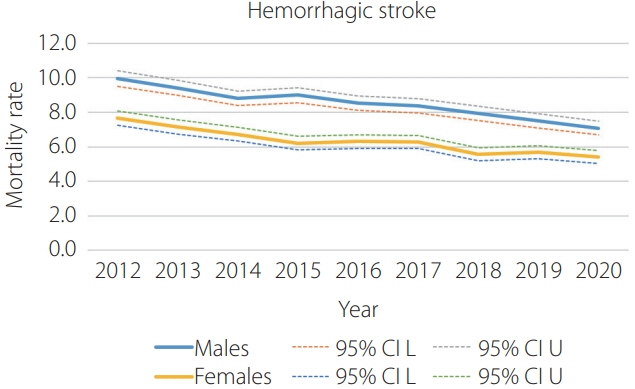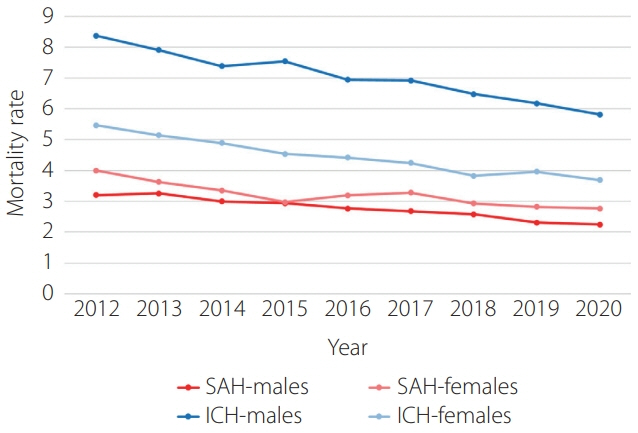Neurointervention.
2022 Jul;17(2):87-92. 10.5469/neuroint.2022.00220.
Trends in Mortality from Hemorrhagic Stroke in Korea from 2012 to 2020
- Affiliations
-
- 1Department of Neurosurgery, Yongin Severance Hospital, Yonsei University College of Medicine, Yongin, Korea
- 2Department of Neurosurgery, International St. Mary’s Hospital, Catholic Kwandong University College of Medicine, Incheon, Korea
- 3Data Science Team, Hanmi Pharm. Co., Ltd., Seoul, Korea
- 4Department of Radiology, Gangnam Severance Hospital, Yonsei University College of Medicine, Seoul, Korea
- KMID: 2531563
- DOI: http://doi.org/10.5469/neuroint.2022.00220
Abstract
- Purpose
To analyze trends in mortality rates from hemorrhagic stroke (HS) according to HS subtypes, using nationwide data from January 2012 to December 2020.
Materials and Methods
We used data from the National Health Claims Database provided by the National Health Insurance Service for 2012–2020 using the International Classification of Disease. The age-adjusted mortality rates of HS, which included subarachnoid hemorrhage (SAH) and intracerebral hemorrhage (ICH), were calculated, and additional analyses were conducted according to age and sex.
Results
The age-adjusted mortality rates for HS, SAH, and ICH decreased substantially in both sexes between 2012 and 2020. During the study period, mortality rates for HS decreased from 8.87 deaths per 100,000 inhabitants to 6.27 deaths per 100,000 inhabitants. Regarding SAH, mortality rates decreased from 3.72 deaths per 100,000 inhabitants to 2.57 deaths per 100,000 inhabitants. Concerning ICH, mortality rates decreased from 6.91 deaths per 100,000 inhabitants to 4.75 deaths per 100,000 inhabitants. The average annual percentage change for HS, SAH, and ICH was –0.04, –0.04, and –0.05, respectively. Mortality rates from HS, SAH, and ICH in both sexes decreased from 2012 to 2020 in all age groups.
Conclusion
In Korea, the age-adjusted mortality rate of HS, SAH, and ICH demonstrated a declining trend in both sexes and across all age groups. These results may aid in the design and improvement of preventive strategies.
Keyword
Figure
Cited by 1 articles
-
Telemedicine Protocols for the Management of Patients with Acute Spontaneous Intracerebral Hemorrhage in Rural and Medically Underserved Areas in Gangwon State : Recommendations for Doctors with Less Expertise at Local Emergency Rooms
Hyo Sub Jun, Kuhyun Yang, Jongyeon Kim, Jin Pyeong Jeon, Sun Jeong Kim, Jun Hyong Ahn, Seung Jin Lee, Hyuk Jai Choi, In Bok Chang, Jeong Jin Park, Jong-Kook Rhim, Sung-Chul Jin, Sung Min Cho, Sung-Pil Joo, Seung Hun Sheen, Sang Hyung Lee
J Korean Neurosurg Soc. 2024;67(4):385-396. doi: 10.3340/jkns.2023.0199.
Reference
-
1. Deaton C, Froelicher ES, Wu LH, Ho C, Shishani K, Jaarsma T. The global burden of cardiovascular disease. Eur J Cardiovasc Nurs. 2011; 10 Suppl 2:S5–S13.
Article2. Feigin VL, Lawes CM, Bennett DA, Anderson CS. Stroke epidemiology: a review of population-based studies of incidence, prevalence, and case-fatality in the late 20th century. Lancet Neurol. 2003; 2:43–53.
Article3. Sarti C, Rastenyte D, Cepaitis Z, Tuomilehto J. International trends in mortality from stroke, 1968 to 1994. Stroke. 2000; 31:1588–1601.
Article4. Kunst AE, Amiri M, Janssen F. The decline in stroke mortality: exploration of future trends in 7 Western European countries. Stroke. 2011; 42:2126–2130.5. Pham TM, Fujino Y, Kubo T, Murata A, Le DC, Ozasa K, et al. Premature mortality due to stroke and trend in stroke mortality in Japan (1980-2005). Eur J Public Health. 2011; 21:609–612.
Article6. Lee SW, Kim HC, Lee HS, Suh I. Thirty-year trends in mortality from cerebrovascular diseases in Korea. Korean Circ J. 2016; 46:507–514.
Article7. Harmsen P, Tsipogianni A, Wilhelmsen L. Stroke incidence rates were unchanged, while fatality rates declined, during 1971-1987 in Göteborg, Sweden. Stroke. 1992; 23:1410–1415.
Article8. Hong KS, Bang OY, Kang DW, Yu KH, Bae HJ, Lee JS, et al. Stroke statistics in Korea: part I. Epidemiology and risk factors: a report from the Korean Stroke Society and Clinical Research Center For Stroke. J Stroke. 2013; 15:2–20.
Article9. Lee EJ, Lee HJ, Hyun MK, Choi JE, Kim JH, Lee NR, et al. Rupture rate for patients with untreated unruptured intracranial aneurysms in South Korea during 2006-2009. J Neurosurg. 2012; 117:53–59.
Article10. Lee SU, Kim T, Kwon OK, Bang JS, Ban SP, Byoun HS, et al. Trends in the incidence and treatment of cerebrovascular diseases in Korea: part II. Cerebral infarction, cerebral arterial stenosis, and Moyamoya disease. J Korean Neurosurg Soc. 2020; 63:69–79.
Article11. Lee JH, Yang DH, Park HS, Cho Y, Jun JE, Park WH, HYpertension-Diabetes Daegu Initiative Study Investigators, et al. Incidence of hypertension in Korea: 5-year follow-up study. J Korean Med Sci. 2011; 26:1286–1292.
Article12. Avezum Á, Costa-Filho FF, Pieri A, Martins SO, Marin-Neto JA. Stroke in Latin America: burden of disease and opportunities for prevention. Glob Heart. 2015; 10:323–331.
Article13. Cruz C, Campuzano-Rincón JC, Calleja-Castillo JM, Hernández-Álvarez A, Parra MD, Moreno-Macias H, et al. Temporal trends in mortality from ischemic and hemorrhagic stroke in Mexico, 1980-2012. J Stroke Cerebrovasc Dis. 2017; 26:725–732.
Article14. Sarti C, Stegmayr B, Tolonen H, Mähönen M, Tuomilehto J, Asplund K; WHO MONICA Project. Are changes in mortality from stroke caused by changes in stroke event rates or case fatality? Results from the WHO MONICA project. Stroke. 2003; 34:1833–1840.
Article15. Bajaj A, Schernhammer ES, Haidinger G, Waldhör T. Trends in mortality from stroke in Austria, 1980-2008. Wien Klin Wochenschr. 2010; 122:346–353.
Article16. Lotufo PA, Goulart AC, Fernandes TG, Benseñor IM. A reappraisal of stroke mortality trends in Brazil (1979-2009). Int J Stroke. 2013; 8:155–163.
Article17. Haast RA, Gustafson DR, Kiliaan AJ. Sex differences in stroke. J Cereb Blood Flow Metab. 2012; 32:2100–2107.
Article18. Reeves MJ, Bushnell CD, Howard G, Gargano JW, Duncan PW, Lynch G, et al. Sex differences in stroke: epidemiology, clinical presentation, medical care, and outcomes. Lancet Neurol. 2008; 7:915–926.
Article
- Full Text Links
- Actions
-
Cited
- CITED
-
- Close
- Share
- Similar articles
-
- Thirty-Year Trends in Mortality from Cerebrovascular Diseases in Korea
- Incidence and Pathophysiology of Cerebral Hemorrhagic Stroke in the Elderly
- Simultaneous Onset of Ischemic and Hemorrhagic Stroke Due To Intracranial Artery Dissection
- Differences in Prevalence and Risk Factors of the Metabolic Syndrome Between Hemorrhagic Stroke and Normal Control
- Causes and Trends of Disabilities in Community-Dwelling Stroke Survivors: A Population-Based Study




